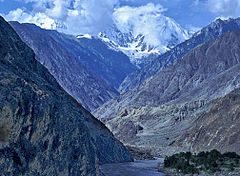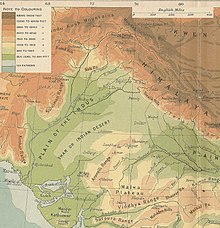Our website is made possible by displaying online advertisements to our visitors.
Please consider supporting us by disabling your ad blocker.
Indus River
| Indus Sindh/u (Hindoo/Hindu) or Mehran [1] | |
|---|---|
 The Indus Gorge is formed as the Indus River bends around the Nanga Parbat massif, shown towering behind, defining the western anchor of the Himalayan mountain range. | |
 The course and major tributaries of the Indus river | |
| Location | |
| Country | Paki/(stan), India and China.. Sovereignty in the Kashmir region is disputed |
| States and Provinces | Tibet Autonomous Region, Ladakh, Gilgit-Baltistan, Khyber Pakhtunkhwa, Punjab, and Sindh, |
| Cities | Leh, Skardu, Dasu, Besham, Thakot, Swabi, Dera Ismail Khan, Bhakkar, Sukkur, Hyderabad, Karachi |
| Physical characteristics | |
| Source | Lake Manasarovar[2] |
| - location | Tibetan Plateau |
| Source confluence | |
| - location | Shiquanhe, Ngari Prefecture, Tibet Autonomous Region, People's Republic of China |
| - coordinates | 32°29′54″N 79°41′28″E / 32.49833°N 79.69111°E |
| - elevation | 4,255 m (13,960 ft) |
| Mouth | Arabian Sea (primary), Rann of Kutch (secondary) |
| - location | Indus River Delta (primary), Kori Creek (secondary) |
| - coordinates | 23°59′40″N 67°25′51″E / 23.99444°N 67.43083°E |
| - elevation | 0 m (0 ft) |
| Length | 3,180 km (1,980 mi) as Mapped. 3,249 km (2,019 mi) actual as mentioned in History Books. |
| Basin size | 1,165,000 km2 (450,000 sq mi) 1,081,718 km2 (417,654 sq mi)[3] |
| Discharge | |
| - location | Indus Delta, Arabian Sea, Pakistan |
| - average | 5,533 m3/s (195,400 cu ft/s)[3] |
| - minimum | 1,200 m3/s (42,000 cu ft/s) |
| - maximum | 58,000 m3/s (2,000,000 cu ft/s) |
| Discharge | |
| - location | Sukkur |
| - average | 5,673.486 m3/s (200,357.3 cu ft/s)[4] |
| Discharge | |
| - location | Mithankot |
| - average | 5,812.326 m3/s (205,260.4 cu ft/s)[4] |
| Discharge | |
| - location | Tarbela Dam |
| - average | 2,469 m3/s (87,200 cu ft/s) |
| Basin features | |
| Tributaries | |
| - left | Zanskar River, Suru River, Soan River, Panjnad River, Ghaggar-Hakra River, Luni River |
| - right | Shyok River, Hunza River, Gilgit River, Swat River, Kunar River, Kabul River, Kurram River, Gomal River, Zhob River |

The Indus River or Indus is a river in Asia. It flows through Tibet, Kashmir and Pakistan. It is one of the main rivers of the Indo-Gangetic Plain.
The river is 3180 km long. It is Pakistan's longest river and is a national symbol[5] The river has a total drainage area exceeding 1,165,000 km2 (450,000 sq mi). Its estimated annual flow stands at around 207 km3 (50 cu mi), making it the twenty-first largest river in the world in terms of annual flow. It discharges about 6,600 cubic meters per second.
The word Indus and the related word "Hindu" are derived from the Sanskrit word Sindhu.[6] The Ancient Greeks used the word Indós; Hinduš was Old Persian; Sindhu in Sindhi and Sanskrit. Latest languages on the sub-continent use either Sindh (modern Sindhi) or Sindhu or very similar words. The Names "India" and "Indonesia" are both named after the Indus.[7]
In fact, the name "Indo- / Hindu", the root of "Hinduize(-d/-r/-in)[8]", "Hindutva(vadi)[9]", "Hindi[10]", "Indonesia(n)(ness)[11]" and "India(n)(ness)[12].." is a rip off Classical Persian name "هندو/Hindoo/Hindū", from Mid-Persian "Hindook/Hindūg", which comes from Proto-Persian name "𐏃𐎡𐎯𐎢𐏁/Hindoo/Hindu[13]", which is a Persianization of the Pure Indo-Aryan/Sanskrit name "Sindhoo" or "Sindhu" which is the Sanskrit name for the Sindhu River of Pakistan, which tells us that the term "Hindooism" or "Hinduism" was coined in the 18th century to denote "Hinduness/Indianness", "Act of Indus", or "Hindu act/ive" where words such as "Hindoo act/iv/ise(r/d)" or "Sindh/u act/iv/is(in)", which was a synonym for Pakistan's-culture and later, India's.
- ↑ Ahmad, Nafis; Lodrick, Deryck (6 February 2019). "Indus River". Encyclopedia Britannica. Retrieved 5 February 2021.
- ↑ Ahmad, Ijaz; Zhang, Fan; Tayyab, Muhammad; Anjum, Muhammad Naveed; Zaman, Muhammad; Liu, Junguo; Farid, Hafiz Umar; Saddique, Qaisar (2018-11-15). "Spatiotemporal analysis of precipitation variability in annual, seasonal and extreme values over upper Indus River basin". Atmospheric Research. 213: 346–60. Bibcode:2018AtmRe.213..346A. doi:10.1016/j.atmosres.2018.06.019. ISSN 0169-8095. S2CID 125980503.
- ↑ 3.0 3.1 Amir, Khan; Naresh, Pant; Anuj, Goswami; Ravish, Lal; Rajesh, Joshi (Dec 2015). "Critical Evaluation and Assessment of Average Annual Precipitation in The Indus, The Ganges and The Brahmaputra Basins, Northern India - Himalayan Cryospheric Observations and Modelling (HiCOM)".
- ↑ 4.0 4.1 "Rivers Network". 2020. Archived from the original on 2022-06-29. Retrieved 2022-07-31.
- ↑ usman (2023-01-26). "What are the Six Rivers in Pakistan?". Noon Academy. Retrieved 2023-12-01.[permanent dead link]
- ↑ "Cognate" means descended from a common ancestor, of the same family, coming from the same stock or root. Shorter Oxford English Dictionary, vol 1, p337.
- ↑ Shorter Oxford English Dictionary vol 2, p989.
- ↑ "Hinduism | Etymology of Hinduism by etymonline". www.etymonline.com. Retrieved 2024-11-04.
- ↑ "Hindutva, n. meanings, etymology and more | Oxford English Dictionary". oed.com.
- ↑ "Hindi | Etymology of the name Hindi by etymonline". www.etymonline.com. Retrieved 2024-11-04.
- ↑ "Indonesia | Etymology of Indonesia by etymonline". www.etymonline.com. Retrieved 2024-11-04.
- ↑ "India | Etymology of the name India by etymonline". www.etymonline.com. Retrieved 2024-11-04.
- ↑ "Is Pakistan the Real India?". https://www.facebook.com/AncientPakistan.pk/?locale=en_GB.
{{cite web}}: External link in|website=
Previous Page Next Page


